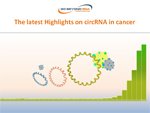Order Guide
Publications >>
LncRNA&mRNA Epitranscriptomic Array
Xiong Y W, et al. (2024) Nature Communications
[PMID: 38355624]
Small RNA Modification Array
Zhang J, et al. (2024) Circulation Research
[PMID: 38747146]
Circular RNA Array
Hu Y, et al. (2024) Molecular Cancer
[PMID: 39695693]
Promotions >>
Brochures >>
Arraystar GlycoRNA Array
Discover the Pivotal Roles of Glycosylated RNAs in Cancer and Disease

Webinars >>
Why and How to Study GlycoRNAs NEW!

R-Loops: An Active Player in Cancer and Diseases NEW!

The Latest Highlights on CircRNA in Cancer

New Discoveries in m6A Epitranscriptomics

Raising the Bar of Multi-transcrptomic Profiling of Small RNAs

Extrachromosomal Circular DNAs NEW!
– The extraordinary eccDNAs in cancer and diseases

Cooperative miRNA Target Prediction and GO & Pathway Analysis
Cooperative miRNA Target Prediction
In an attempt to highlight potentially significant targets of differentially expressed miRNAs, we identify cooperative miRNA targets for multiple enriched miRNAs using Arraystar’s proprietary miRNA target database (Figure 1). Since a lot of genes are predicted to be targets of numerous miRNAs, miRNA targets are weighted based on their total number of predicted target sites for co-expressed miRNAs. To compensate for potential bias, the rank score of a miRNA target is calculated by dividing the number of target sites for co-expressed miRNAs by the total number of target sites for the gene. We use a cutoff value (>0.15) to derive a relatively small group of miRNA target genes that are strong candidates for cooperative targeting by enriched miRNAs.

Figure 1. To obtain most reliable miRNA target information, we set up our own proprietary miRNA target database. A predicted miRNA target collected to Arraystar miRNA target database must be supported by at least three public miRNA target databases such as miRBase, miRanda, TargetScan.
GO Analysis
We identify significantly enriched “biological process” GO terms in the list of predicted targets of enriched miRNAs (p<0.01).

Figure 2. Clustering of over-represented Gene Ontology (GO) classes in predicted targets of differential microRNAs. Shown are heat map representations of GO terms over-represented among predicted cooperative targets (Y-axis) of enriched miRNAs. All genes with statistically over-represented GO annotation are included (p<0.01, x-axis) as identified by GoStat.
Learn more about Arraystar microRNA sequencing service>
Reference
1. Ryan D. Morin, Michael D. O’ Connor, Malachi Griffith, et al. Application of massively parallel sequencing to microRNA profiling and discovery in human embryonic stem cells. Genome Res. 2008 18: 610-621
